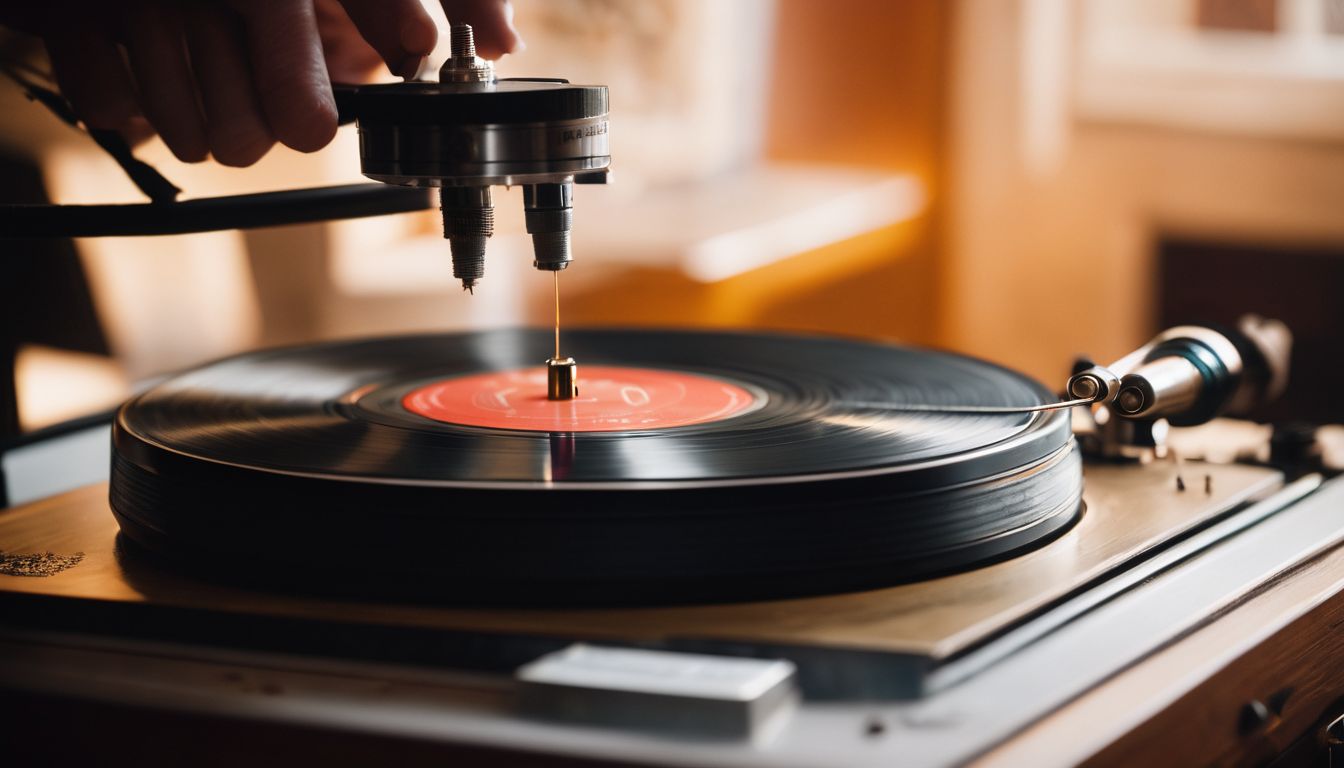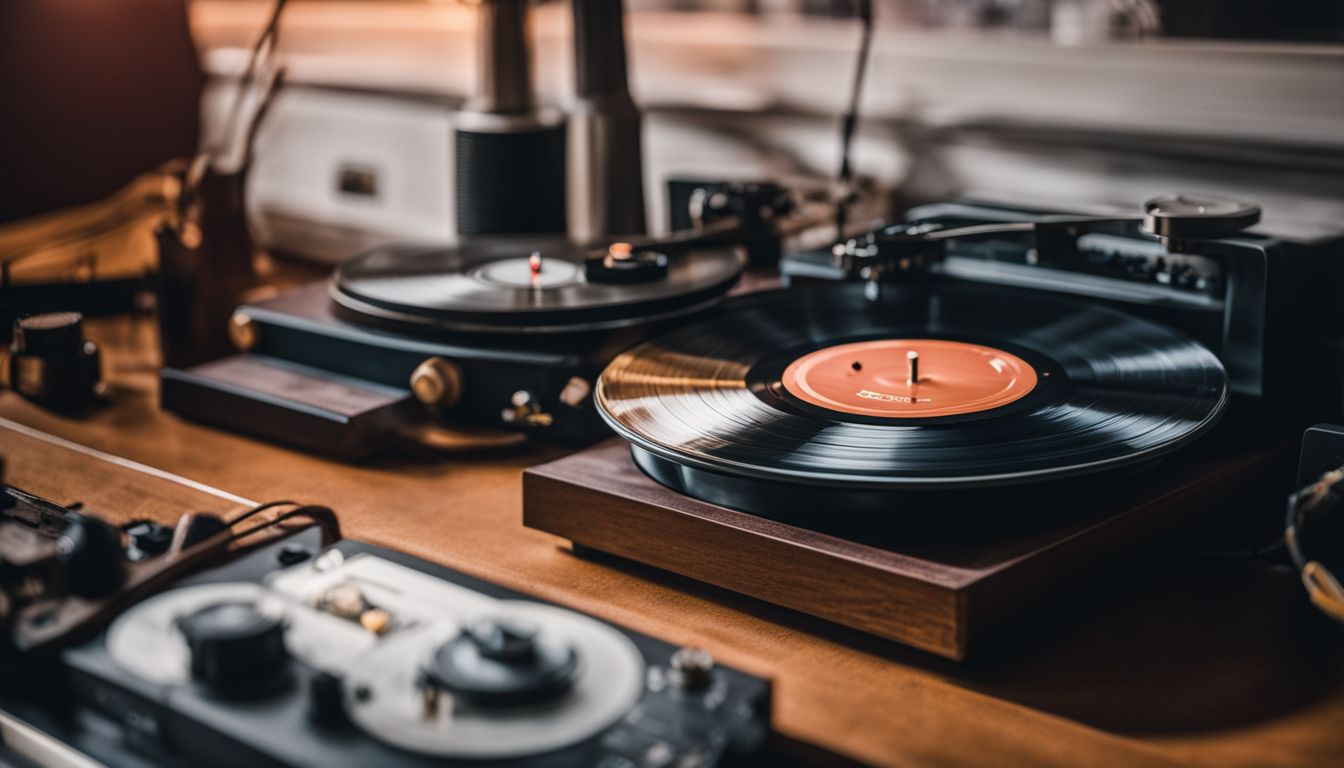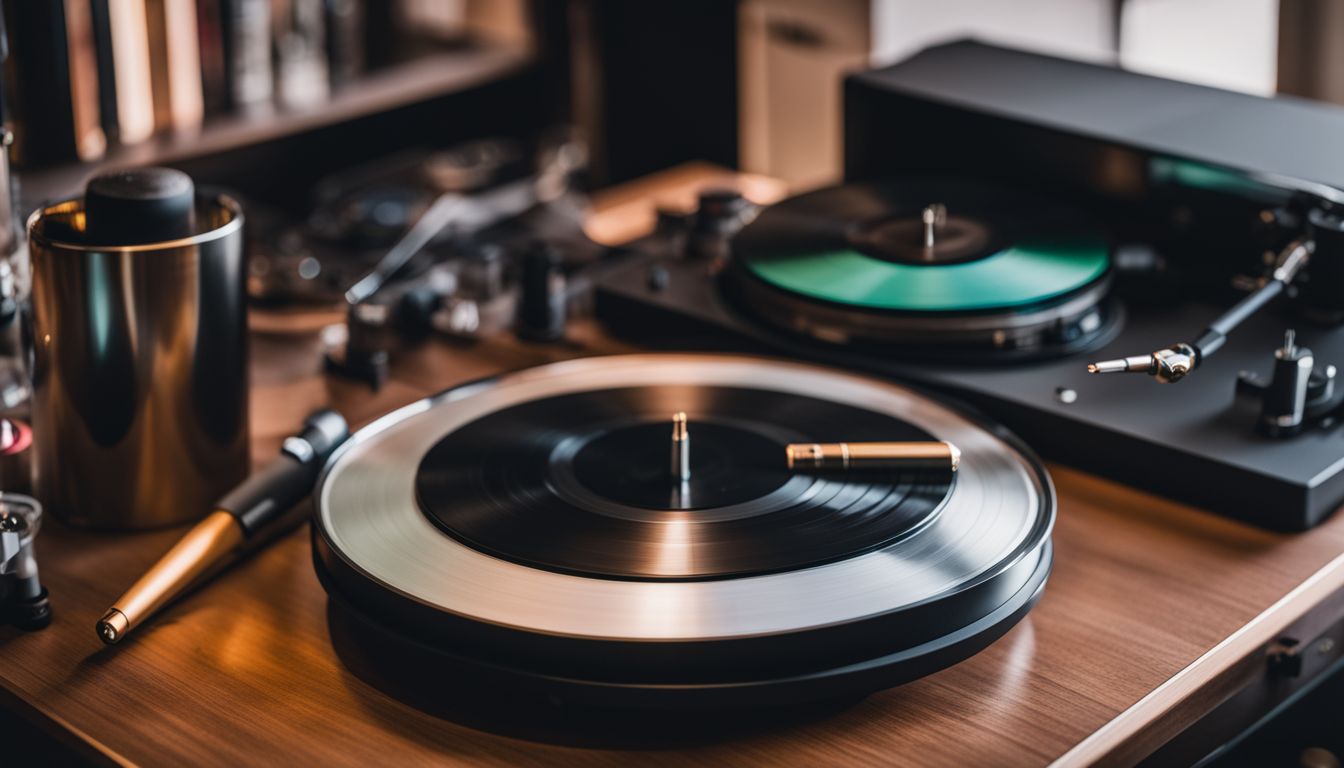Struggling to get that perfect sound from your vinyl records? The secret often lies in the heart of your turntable: the needle or stylus. Discovering how this tiny tool works can transform your listening experience, offering a deeper appreciation for the grooves spinning on your favorite record player.
Let’s explore the mechanics and magic behind needle turntables, inviting you to dive into a world where clarity meets melody. Keep reading and tap into the vibrant soundscape of vinyl playback!
Key Takeaways
- The needle or stylus, is the main tool that reads vinyl records, turning grooves into music.
- Different types of stylus shapes, like conical and elliptical, affect sound accuracy and detail.
- Cartridges contain the stylus and are vital for translating vibrations into electrical signals.
- High-quality materials, such as diamond tips and aluminum cantilevers, improve sound fidelity.
- Regular maintenance, proper alignment, and timely replacement of parts are essential for preserving turntable performance.
Understanding the Function of the Needle Turntable
The needle turntable, a classic component of record players, operates as the primary point of contact between your vinyl records and the music you hear. A small but mighty hero, the stylus traces the intricate grooves on the record’s surface with precision.
This delicate process transforms mechanical vibrations into an electrical signal, which then travels through various amplification stages before filling your room with sound.
Cherished by audiophiles for its rich sound reproduction, every detail in this system matters—from the tip of the diamond stylus down to its shape. Conical styli offer robust performance and forgiving tracking, while elliptical styli provide acute accuracy for high-fidelity listening.
Each movement picked up by these needles is crucial; hence, cartridges equipped with aluminum cantilevers are sought after for their ability to faithfully carry frequencies without loss or distortion.
Selecting a high-quality phono cartridge can elevate your listening experience profoundly, revealing nuances in music that lesser systems might miss.
The Role and Importance of the Stylus
A turntable stylus, often simply called a needle, acts as the translator between the grooves of your vinyl records and the music you hear through your speakers. This tiny but mighty component traces the intricate patterns carved into the record’s surface, picking up every detail embedded within.
This contact creates vibrations as it glides through the twists and turns of each record groove. These vibrations are essential—they become electrical currents that later transform into audible sound waves.
Choosing a top-notch stylus is critical for protecting your valued vinyl collection from abrasion and wear. A high-end stylus minimizes damage to records by using precision engineering to follow grooves accurately without applying excess pressure—think of it like a skilled dancer moving lightly but precisely on a dance floor.
Meanwhile, quality materials in its construction ensure longevity and consistent performance over time. The intersection where cartridge technology meets stylus design determines how faithfully audio can be reproduced; aluminum cantilevers paired with sophisticated magnet setups result in a clean transmission system, all leading to an experience that brings every beat, lyric, and melody alive with clarity and depth straight from your turntable to your amplifier or stereo receiver.
Different types of stylus
4. Different Types of Stylus: Delving into the diverse world of styluses reveals their unique shapes and contact points, which are critical in determining the nuances and fidelity of your vinyl listening experience. Discover why choosing the right one can elevate your auditory journey.
Conical Stylus
Conical styluses are the go-to for many music enthusiasts just starting their vinyl journey. With a rounded tip that makes it easy to fit into record grooves, they pick up sound waves with simplicity and efficiency.
These tips ensure they capture the essence of the track being played by gliding over large areas of the groove walls.
Users often favor conical styli because they’re forgiving on worn records and are less prone to misalignment issues. They serve as a sturdy choice within the moving magnet cartridges found in entry-level turntables, providing an accessible option for those eager to dive into the world of analog audio without breaking the bank.
Offering consistent performance, conical styli play an integral role in bringing classic sounds to life in homes around the world.
Elliptical Stylus
An elliptical stylus takes sound reproduction to the next level, outperforming its conical counterpart by reaching deeper into a vinyl record’s grooves. This type of stylus mimics the shape of a record-cutting head, which enables it to pick up subtleties in music with greater precision.
Listeners enjoy an audio experience that boasts fewer distortions and richer detail.
Crafted with precision engineering, the elliptical stylus is often mounted on aluminum cantilevers for optimal frequency-range transmission. Its delicate yet agile design allows a more accurate representation of recordings, delivering unparalleled clarity.
Moving coils within these systems further enhance sound quality, turning every listen into an immersive sonic journey. Audio enthusiasts seek out this sophisticated component to improve their listening experiences and guarantee faithful amplification of each note from groove to speaker.
The Cartridge and its Role
The cartridge is a critical component of the turntable that translates the record’s grooves into sound. It houses several elements necessary for accurate audio reproduction.
The cantilever within the cartridge acts like a bridge; it connects to the stylus on one end and swings from a fixed pivot point on the other.
Under the cantilever, suspension systems allow movement while maintaining stability, ensuring precise tracking of record grooves.
Integrated coils work together with magnets to generate electrical signals by moving within a magnetic field in response to groove vibrations.
These generators come in two main types: moving magnets (MM) and moving coils (MC), each with distinct characteristics influencing sound output.
A quality cartridge often employs an aluminum cantilever for enhanced frequency transmission, allowing listeners to experience every detail in their music.
Due to their refined design, moving coil cartridges deliver superior precision and are coveted by audiophiles for top-notch sound clarity.
Recognizing differences between low-end and high-end cartridges may be challenging but investing in quality will noticeably improve your listening experience.
What is a Cartridge in a Turntable: Exploring its Functions and Quality Factors
Diving deeper into the turntable’s heart, we find that the cartridge is a powerhouse of audio translation. It houses the stylus or needle, which gently reads the grooves of a vinyl record.
As it travels along these tiny paths, the stylus transfers vibrations through the cantilever to the coil and magnet inside this critical piece of equipment. These components work in harmony to convert mechanical energy into an electrical signal that eventually becomes sound.
Quality factors play a crucial role in how well this conversion happens. Higher-end models often feature aluminum cantilevers for their accuracy and durability. They help maintain clarity by precisely transferring frequencies from records to speakers without losing detail.
Moreover, moving magnet generators inherent to many cartridges ensure longevity and make maintenance simpler compared with their moving coil counterparts. Although both types have merits regarding sound reproduction prowess, users should consider compatibility with tonearms and preamps when selecting their setup.
Investing wisely in a solid cartridge can elevate your listening experience dramatically by minimizing noise levels while amplifying fidelity on every track spun.
Factors Affecting the Quality of Cartridges
Exploring the functions and quality factors of cartridges leads us to consider what influences their performance. Several key elements determine a cartridge’s quality and, as a result, the sound that it produces when playing records.
- A stylus made from diamond or another hard material usually lasts longer and provides a more accurate reading of the record grooves. It picks up subtle nuances in music, affecting sound clarity and detail.
- Shape of the Stylus: The stylus can be conical or elliptical, with each shape interacting differently with record grooves. An elliptical stylus often captures more detail because it has more contact with the vinyl surface.
- The construction of the cantilever: The cantilever transfers vibrations between the stylus and cartridge body. Many manufacturers commonly use aluminum due to its rigidity and precise frequency conduction.
- Cartridge Type: Moving magnet (MM) cartridges are known for being user-friendly and having replaceable needles. Moving coil (MC) cartridges typically offer superior sound but are more complex and usually require professional installation.
- Generator Mechanism: Whether a cartridge uses a moving magnet or moving coil affects its performance. Each type generates audio signals differently, which impacts sound quality drastically.
- Alignment Accuracy: Proper alignment of the cartridge is crucial; even slight misalignments can cause distortions or reduce audio fidelity.
- Electrical Output: Cartridges with higher output levels may not require additional pre-amplification, simplifying setup but potentially impacting nuanced sound reproduction.
How the Stylus and Cartridge Work Together
Understanding the factors that affect cartridge quality, we can now dive into how the stylus and cartridge work in unison. This partnership is essential for translating vinyl grooves into music.
- The stylus, or needle, reads the physical grooves on a record. Its tip moves along tiny ridges cut into the vinyl, vibrating as it goes.
- These vibrations travel through the stylus to the cantilever. Think of this as a tiny rod inside your cartridge that moves with your needle.
- At one end of the cantilever sits a magnet or set of coils. As this assembly vibrates, an electromagnetic generator comes into play.
- Through this generator, which may be magnetic or coil-based, an electrical signal is created from mechanical movement.
- This generated signal travels down wires to reach your turntable’s amplifier.
- Once there, it gets boosted up so that what was once a tiny vibration turns into sound powerful enough for speakers.
- Materials matter; high-quality components within the cartridge ensure better fidelity and less distortion in sound reproduction.
Every element must perform flawlessly together—like dancers in perfect sync—to produce clear and rich audio from your records.
Importance of Proper Maintenance and Replacement
Keeping your turntable in top condition means giving proper attention to maintenance and replacement. This ensures that the delicate balance between the stylus and cartridge continues to produce the best sound possible.
- Regular cleaning of the stylus prevents the buildup of dust and dirt, which can distort sound quality.
- Inspecting the stylus for wear is crucial; a worn stylus can damage records or cause audio distortion.
- Replacing cartridges when needed allows for consistent audio fidelity and performance quality.
- Utilizing a universal mount for cartridge installation simplifies upgrades and replacements, making maintenance more manageable.
- Aligning your cartridge correctly affects tracking ability and sound accuracy, highlighting how essential setup precision is.
- Choosing high-quality replacement parts maintains sonic clarity, as investing in better components results in improved acoustics from your vinyl collection.
- Managing turntable elements with care extends their lifespan; gentle handling protects against accidental damage during cleanings or adjustments.
- Checking connection points like wires ensures signal transfer without interference, keeping sounds crisp and clear.
Conclusion
Every spin of a record relies on the precision of the needle turntable. A high-quality stylus and cartridge team up to unearth every note from your favorite vinyl. Trust in their synergy to deliver crystal-clear sound straight to your speakers, lifting each tune into the air with unmistakable clarity.
Remember, fine-tuning your turntable’s components redefines audio experiences, allowing you to immerse fully in music’s timeless magic. Your turntable doesn’t just play records; it breathes life into every melody it touches.
To delve deeper into the heart of your turntable’s sound, discover more about turntable cartridges and their intricate role in music playback.
FAQs
What exactly is a needle turntable?
A needle turntable is a component of a record player that uses a needle to read the grooves on vinyl records and produce sound.
Why is the needle so important on a turntable?
The quality of the needle influences how accurately it can translate the grooves on a record into audio signals, which makes it essential for high-fidelity sound reproduction.
How does a needle turntable work?
As the vinyl record spins, the needle—also known as the stylus—traces its grooves. This contact converts vibrations into electrical signals that become music we can hear through speakers or headphones.
Can you replace needles on turntables if they wear out or break?
Yes, you can replace worn-out or broken needles on most turntables to ensure continuous, high-quality sound output and avoid damaging your valuable vinyl records.


